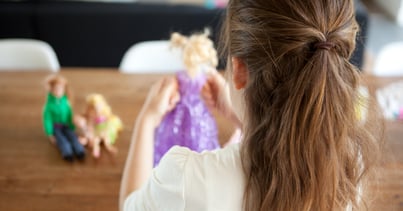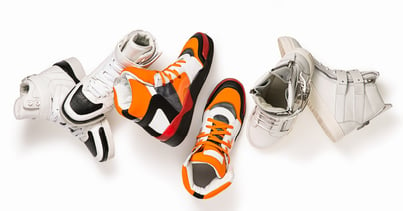St. Cloud, MN
619 W St. Germain St., Suite 214
St Cloud, MN 56301
(320) 203-4840
Green Bay, WI
520 N Broadway, Suite 270
Green Bay WI, 54303
(920) 884-1496
St. Cloud, MN
619 W St. Germain St., Suite 214
St Cloud, MN 56301
(320) 203-4840
Green Bay, WI
520 N Broadway, Suite 270
Green Bay WI, 54303
(920) 884-1496

A recent study found that brand loyalty is on the up and up, with 72% of consumers prepared to pay more to purchase from their preferred brands. Sounds great, right? It is — as long as you can earn consumer loyalty.
That’s where branding and marketing step in. But what’s the difference? Which one do you need? And where should you invest your money right now to build that deep sense of consumer loyalty?
Let’s answer those questions using one of my favorite iconic brands.
I was obsessed with dolls when I was six. But because my family wasn’t made of money, and my lemonade stand was full of fruit but not entirely fruitful, I was stuck with the lesser-known knockoff doll named Sindy.
Why did six-year-old me assume that Sindy wasn’t as good as Barbie?

Because I knew a lot about Barbie. I knew she came in bright pink boxes with tropical backgrounds. In a colorful Lisa Frank world, Barbie’s brand was simplified to a stark pink-and-white contrast. Her packaging was consistent, to the point that I’d know a Barbie even if her name was removed.
On the other hand, Sindy was often showcased in a clear box with blue and purple accents. She didn’t stand out as much on the shelf, and her accessories didn’t have the same exciting pink flare that I’d come to expect every time I opened birthday and Christmas gifts.
From a branding perspective, the Sindy dolls just weren’t as consistent, identifiable, or recognizable.
In the 1990s, I was the target market for doll companies. And despite all of the options, I wanted to be like Barbie. She was a dentist, a vet, a stewardess, and a dog walker.
Sindy, on the other hand, was meant to be a teenager. Her brand team assumed I wanted to see myself in my doll, so she shared a lot of the same hobbies as me, like going clothes shopping and attending pool parties. But in reality, I didn’t want a doll that did all the same things as me — I wanted to see what I would become. Barbie owned a Malibu mansion. She had jobs and drove cars and hosted barbecues. Her tagline was, “You can be anything.”
Barbie’s recognizable face, bubble-gum pink packaging, and cursive logo helped make up a recognizable brand. The fact that she was everywhere was the result of good marketing.
Kids want to dream big, and Barbie allows them to do that. (Barbie also makes it hard for parents to say no to an impromptu doll purchase — because what parent wants to tell their gymnastics-obsessed child they can’t buy and look up to their Olympic Gymnast Barbie?)
Simply put, Barbie’s marketing team took the time to figure out what kids wanted and dreamed about — and then they made those options part of who Barbie was.
So, if kids gravitated towards Barbie on store shelves, how did they know about her to begin with?
Easy. We saw her on television. We owned clothes with her face plastered all over them. She seemed to be everywhere, so much so that she became more of an icon than a doll.
Barbie’s recognizable face, bubble-gum pink packaging, and cursive logo helped make up a recognizable brand. The fact that she was everywhere was the result of good marketing.
If we take Barbie out of the equation, branding is the research-informed approach to making your company recognizable and desirable.
Most people think branding is your logo, color palette, or messaging — and they’re not wrong. But a brand is a lot more than that, including:
To create effective branding, you’re going to have to learn the needs, desires, and habits of your target market. Persona research plays a big part in this. You can put something in front of someone as much as you want. But even if you get more exposure time than your competition, if you don’t speak to what people want, you won’t get their business. 
If dolls aren't your thing, think of Nike. They are known for their sport-centric sneakers — but most people buy Nike shoes because they want to be associated with the sleek style that the brand is associated with (not just because they want sports shoes).
Marketing is the way you get the word out about your product or service. After all of the research that goes into your brand work, it’s how you get in front of your market and let them know how your product or service will help them.
For Barbie in the 1990s, that meant everything from creating commercials to putting her face on scooters, dinner plates, and whatever else that had an open surface area.
What goes into good marketing? A lot of things, including:
The short answer: branding.
While marketing may contribute to your overall brand by effectively getting the word out about what you’re offering, your brand remains even after the marketing campaign has done its work. That’s why we often recommend branding work to clients who come to us initially wanting marketing help only.
Keep in mind that branding doesn’t happen overnight. It takes strategy and planning to successfully create and implement a brand that will not only last, but will encourage people to convert. Your brand is responsible for a lot, so it’s not an area that you want to glaze over. Your investment in brand work can make or break a person’s decision to become a long-term believer in your product or service.
Whether you have a solid brand and are ready for elevated marketing, or need to revisit your brand before your next big marketing push, we’re here to help. Get the tools you need to get started.
We regularly share insights on how we approach marketing. Get on the list.
